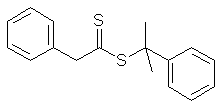The Influence of RAFT Techniques on Emulsion Polymerisation Systems
Supervisors
Prof. R.G. Gilbert, Key Centre for Polymer Colloids, University of
Sydney.
Dr E. Rizzardo, CRC for Polymers, CSIRO Molecular Science.
Dr M.J. Ballard, CSIRO Molecular Science.
Background
Emulsion Polymerisation
Emulsion polymerisation is a laboratory and industrial technique that allows the preparation of polymers with good efficiency and without the use of potentially hazardous solvents. However, in emulsion polymerisation it is difficult to control the chemical composition of individual polymer chains [1]. The ability to perform tailored polymerisation opens the possibility of producing novel polymers able to combine the properties of existing polymers in new ways.
RAFT Techniques
A technique for living free-radical polymerisation that has recently been developed is Reversible Addition-Fragmentation chain Transfer (RAFT) Polymerisation [2]. In RAFT polymerisation, the chains are kept alive by keeping them in a dormant form. By minimising the number of polymeric radicals in the system, termination reactions are less frequent, thus maintaining the living character of the polymer. Thus, while a chain in a normal free-radical polymerisation lives for only a tiny fraction of duration of the overall polymerisation, in a living system, this lifetime is made commensurate with that of the overall process. This enables one to control both the polymer architecture (e.g. to create a block copolymer) and the molecular weight distribution (e.g. making all the chains of very similar length).
Like all living polymerisation techniques, RAFT has been shown to significantly change the molecular weight distribution (MWD) of the resulting polymer. The MWD is typically much narrower; in solution polymerisation systems, a polydispersity (Mw/Mn) of less than 1.2 may be achieved.
While the narrowing of the MWD is of significant academic interest (e.g. providing an easier means of studying the effect of the molecular weight on engineering properties) there are other benefits to flow from RAFT techniques. Perhaps more important from an industrial perspective than the decreased polydispersity is the ability to tailor the molecular architecture of the polymers being synthesised. By choosing appropriate RAFT agents and performing a semi-batch reaction, it is possible to create block copolymers. Such block copolymers are quite useful as compatibilisers in obtaining hybrid properties between otherwise incompatible polymers.
RAFT in Emulsion Polymerisation Systems
Recent studies indicate that RAFT may be used in emulsion and miniemulsion polymerisation systems with some adaptation [3,4]. Preliminary results indicate that considerable work is required before the emulsion RAFT process is understood well enough to be widely used. In particular for emulsion systems, there are difficulties in assessing the suitability of a RAFT agent in terms of how it alters e.g. particle formation, in addition to the selection on the basis of chemical properties. By way of contrast, the selection of a suitable RAFT agent for solution polymerisation is readily done by consideration of the reactive species and the stability of the intermediate forms.
The effects of the RAFT mechanisms on the kinetics of particle formation and particle growth have not as yet been addressed. Trying to understand these effects in archetypal emulsion polymer systems forms the basis of this project.
Description of Research Project
A detailed kinetic study of RAFT systems is being undertaken to quantify the effects of the RAFT mechanisms on emulsion polymerisation systems. The scope of this study includes the determination of some of the physical properties of a RAFT agent that make it suitable for use in emulsion systems, along with establishing the effect of RAFT techniques on the physical processes involved in emulsion polymerisation reactions.
From this fundamental understanding, a predictive model for adapting existing emulsion polymerisation recipes was developed. The adaptation of existing emulsion polymerisation models to predict the MWD of the living polymer chains and the particle size distribution of the latex produced was investigated.
Selection of RAFT Agents
The RAFT agent 2-phenylprop-2-ylphenyldithioacetate (PPPDTA, depicted in Figure 1) was found to be a good RAFT agent for the emulsion polymerisation of styrene.
 Figure 1: The structure of the RAFT agent 2-phenylprop-2-ylphenyldithioacetate (PPPDTA). |
References
(1) Gilbert, R. G. Emulsion Polymerization: A Mechanistic
Approach; Academic: London, 1995.
(2) Rizzardo, E.; Chiefari, J.; Chong, B. Y. K.; Ercole, F.; Krstina,
J.; Jeffery, J.; Le, T. P. T.; Mayadunne, R. T. A.; Meijs, G. F.;
Moad, C. L.; Moad, G.; Thang, S. H. Macromolecular Symposia 1999,
143, 291-307.
(3) Ballard, M.; Ciefari, J.; Chong, B.; Finlay, A.; Jeffery, J.;
Mayadunne, R.; Moad, G.; Rizzardo, E.; Taing, H.; Thang, S. H.
"Engineered Resins Strategic Alliance Technical Report: March
1999 - May 2000," CSIRO Molecular Science, 2000.
(4) Butte, A.; Storti, G.; Morbidelli, M. Macromolecules 2000, 33,
3485-3487.
Last edited: Sunday July 10, 2005
Copyright © 1996-2014 Stuart Prescott